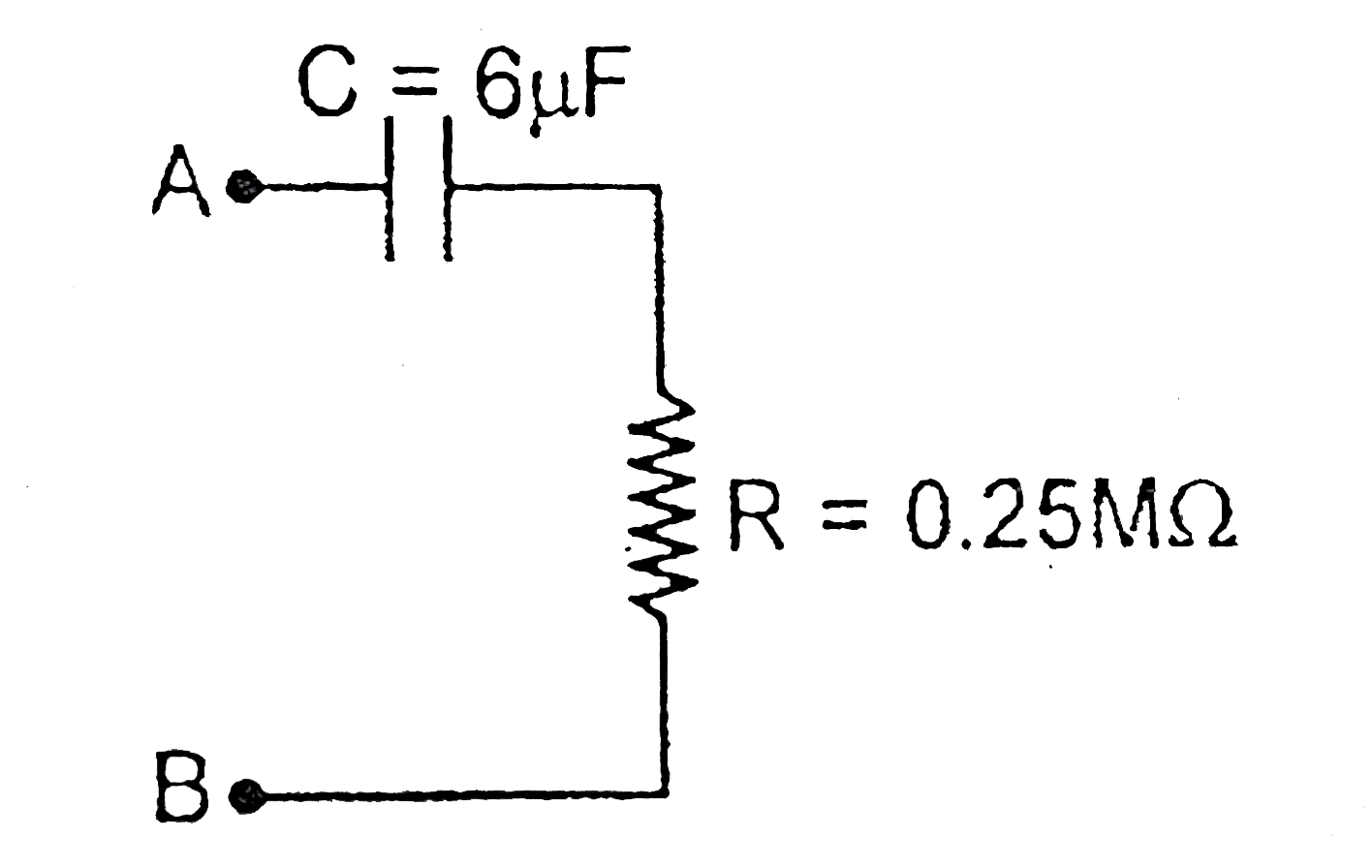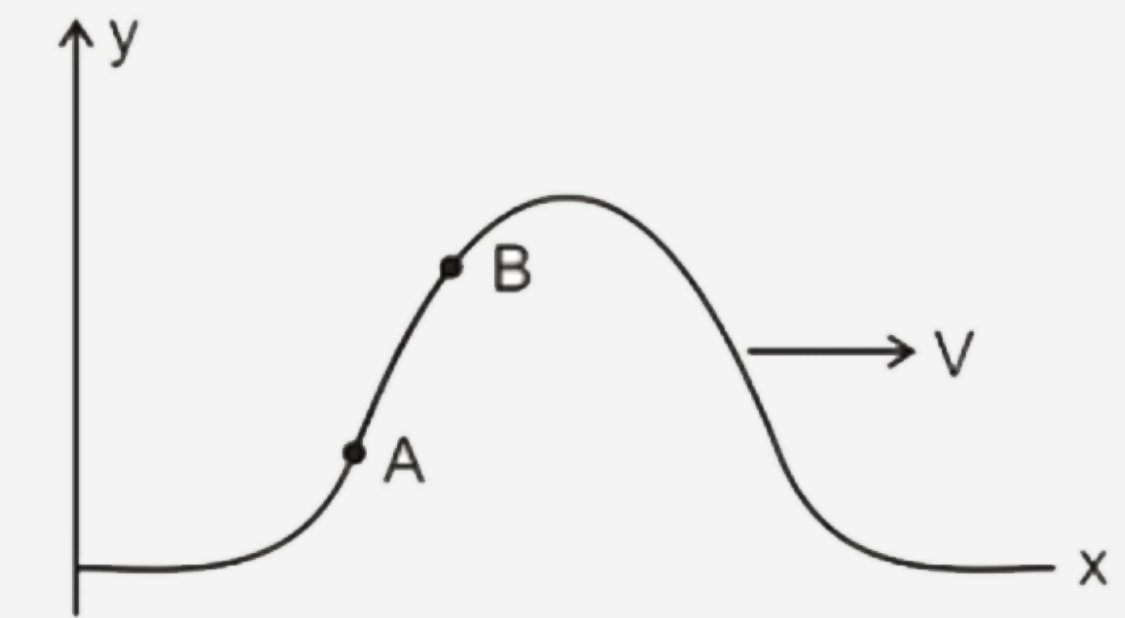In the figure shown a sinusoidal wave is generated at the end 'A'. The wave travels along positive x−axis and during its motions it encounter another string BC at the junction 'B' at x=0. The density of strings AB and BC and ρ and 9ρ respectively and their radii of cross sections are 2r and r. The wave funcation. amplitude and wavelength of incident wavs are respectively yr,Ar,λr and yt,At,λt repectively

The ratio of amplitudes Ar to At is (i.e. A_(r) : A_(t)) will be
1:1
1:4
4:1
None of these
The correct Answer is:B
Medium of string BC is denser. These will be π phase difference between reflected and transmitted wave.
λrλt=v1v2=√μ2μ1
Now μ1μ2=49 so λrλt=32
ArAt=v2−v1v1+v2Ai2v2v1+v2.Ai=v2−v12v2=14
Topper's Solved these Questions
- TRAVELLING WAVESBOOK - RESONANCECHAPTER - TRAVELLING WAVESEXERCISE - Exercise- 3 PART I
19 Videos
- TRAVELLING WAVESBOOK - RESONANCECHAPTER - TRAVELLING WAVESEXERCISE - Exercise- 3 PART II
7 Videos
- TRAVELLING WAVESBOOK - RESONANCECHAPTER - TRAVELLING WAVESEXERCISE - Exercise- 2 PART III
15 Videos
- TEST SERIESBOOK - RESONANCECHAPTER - TEST SERIESEXERCISE - PHYSICS
127 Videos
- WAVE ON STRING BOOK - RESONANCECHAPTER - WAVE ON STRING EXERCISE - Exercise- 3 PART I
19 Videos
Similar Questions
A harmonically moving transverse wave on a string has a maximum particle velocity and acceleration of 3 m/s and 90m/s2 respectively. Velocity of the wave is 20m/s. Find the waveform.
View SolutionA string is stretched betweeb fixed points separated by 75.0cm. It observed to have resonant frequencies of 420Hz and 315Hz. There are no other resonant frequencies between these two. The lowest resonant frequency for this strings is
View SolutionThe plane wave represented by an eqution of the form y = f(x-vt) implies the propagation along the positive x-axis without chang of shape with constant velocity v. Then
View SolutionA time varying voltage is applied across A & B such that voltage across capacitor is given by VC=2sin2t. What is maximum potential difference across the reistance?

View SolutionA transverse wave travelling in a string produce maximum transverse velocity of 3m/s and maximum transverse acceleration 90m/s2 in a particle. If the velocity of wave in the string is 20m/s. Datermine the equation of the wave ?
View SolutionIn the figure shown a sinusoidal wave is generated at the end A the wave travels along positive x-axis and during its motion it encounter another string BD at the junction 'B' at x=0. The density of string AB and BC are rho "and" 9rho respectively and their radii of cross sections are 2r"and"r. The wave function amplitude and wavelength of incident wave are respectively "y"_(p) A_(i)"and"lambda_(r) Similarly for reflected and transmitted wave these peremeters are "y"_(r),A_(r),lambda_(r)"and"y_(i),A_(i),lambda_(i) Which of the following statement regarding phase difference Deltaphi between waves at x=0 is true?
View SolutionIn the figure shown a sinusoidal wave is generated at the end A the wave travels along positive x-axis and during its motion it encounter another string BD at the junction 'B' at x=0. The density of string AB and BC are rho "and" 9rho respectively and their radii of cross sections are 2r"and"r. The wave function amplitude and wavelength of incident wave are respectively "y"_(p) A_(i)"and"lambda_(r) Similarly for reflected and transmitted wave these peremeters are "y"_(r),A_(r),lambda_(r)"and"y_(i),A_(i),lambda_(i) The ratio of wavelengths lambda_(r) "to" lambda_(i) (i.e.lambda_(r):lambda_(t)) will be
View SolutionIn the figure shown a sinusoidal wave is generated at the end A the wave travels along positive x-axis and during its motion it encounter another string BD at the junction 'B' at x=0. The density of string AB and BC are rho "and" 9rho respectively and their radii of cross sections are 2r"and"r. The wave function amplitude and wavelength of incident wave are respectively "y"_(p) A_(i)"and"lambda_(r) Similarly for reflected and transmitted wave these peremeters are "y"_(r),A_(r),lambda_(r)"and"y_(i),A_(i),lambda_(i) The ratio of amplitudes A_(r) "to" A_(r) "is"(i.e.A_(r):A_(t)) will be
View SolutionIn the figure shown a sinusoidal wave is generated at the end 'A'. The wave travels along positive x−axis and during its motions it encounter another string BC at the junction 'B' at x=0. The density of strings AB and BC and ρ and 9ρ respectively and their radii of cross sections are 2r and r. The wave funcation. amplitude and wavelength of incident wavs are respectively yr,Ar,λr and yt,At,λt repectively

Which of the following statement regarding phase difference, Δϕ between waves at x=0 is true ?
View SolutionIn the figure shown a sinusoidal wave is generated at the end 'A' . The wave travels along positive x- axis and during its motions it encounter another string BC at the junction 'B' at x = 0 . The density of strings AB and BC and rho and 9rho respectively and their radii of cross sections are 2r and r . The wave funcation. amplitude and wavelength of incident wavs are respectively y_(r), A_(r), lambda_(r) and y_(t), A_(t), lambda_(t) repectively The ratio of wavelengths lambda_(r) to lambda_(t) (i.e. lambda_(r) : lambda_(t) ) will be
View SolutionIn the figure shown a sinusoidal wave is generated at the end 'A'. The wave travels along positive x−axis and during its motions it encounter another string BC at the junction 'B' at x=0. The density of strings AB and BC and ρ and 9ρ respectively and their radii of cross sections are 2r and r. The wave funcation. amplitude and wavelength of incident wavs are respectively yr,Ar,λr and yt,At,λt repectively

The ratio of amplitudes Ar to At is (i.e. A_(r) : A_(t)) will be
View SolutionIn the figure shown a sinusoidal wave is generated at the end 'A'. The wave travels along positive x−axis and during its motions it encounter another string BC at the junction 'B' at x=0. The density of strings AB and BC and ρ and 9ρ respectively and their radii of cross sections are 2r and r. The wave funcation. amplitude and wavelength of incident wavs are respectively yr,Ar,λr and yt,At,λt repectively

Which of the following statement regarding phase difference, Δϕ between waves at x=0 is true ?
View SolutionIn the figure shown a sinusoidal wave is generated at the end 'A'. The wave travels along positive x−axis and during its motions it encounter another string BC at the junction 'B' at x=0. The density of strings AB and BC and ρ and 9ρ respectively and their radii of cross sections are 2r and r. The wave funcation. amplitude and wavelength of incident wavs are respectively yr,Ar,λr and yt,At,λt repectively

The ratio of wavelengths λr to λt (i.e. λr:λt) will be
View SolutionA wave pulse is generated in a string that lies along x-axis. At the points A and B, as shown in figure, if R_A and R_B are ratio of wave speed to the particle speed respectively then :
View SolutionA wave pulse is generated in a string that lies along x- axis. At the points A and B, as shown in the figure, if RAandRB are the ratio of wave speed to the particle speed respectively then:

View Solution

